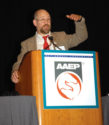Advertise Follow Us
Anatomy
Check out these valuable footcare ideas from the mid-December annual meeting of the American Association of Equine Practitioners
Read More
An Equine Foot Form and Function Review
Hall Of Fame equine vet stresses importance of anatomical relationships during clinic
Read More
Managing the Crooked Horse
Most equines are out of alignment one way or another — and a farrier can’t always fix it
Read More
Hoof Care and the Coffin Bone
Understanding the form and function of the distal phalanx is vital to keeping horses sound
Read More
Precise Measurements Emphasize Biomechanics for Balance, Breakover
Proper management includes critical measurements that allow a farrier to position the breakover point to meet the functional needs of the horse throughout the shoeing cycle
Read More
A Horseshoer's Approach to Heart Bars
Myron McLane has spent two decades explaining the importance and application of these shoes
Read More
Back to the Basics
When Good Hooves Go Bad
Hoof distortion often hides a nice symmetrical foot
Read More
Leaning Horses, Revealing Hooves
Anatomy disposes horses to lean, a fact overlooked by most riders and farriers, but it could be the underlying cause of the hoof wear and growth patterns that shoers must deal with
Read More
The Hoof and Equine Performance
Hall Of Fame vet says many variables are involved with hoof care’s impact on athletic horses
Read More
Equine Anatomy
Last Of The Ligaments — Sort Of
There are actually many more, but these seven wrap up this look at the ligaments most important for shoers
Read More












